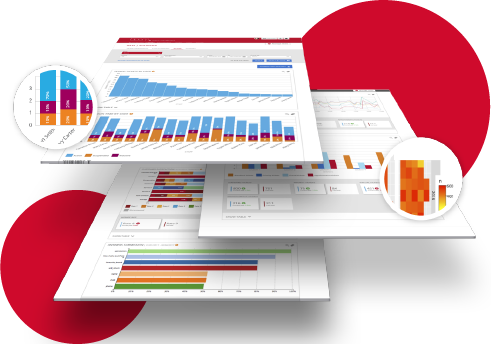Statistics are an essential tool to improve the efficiency of customer service.
Statistics act as the brain of service management and are increasingly being used as tools to support the decision-making process. The use of statistical data provides real-time information and is a strong helper to prevent hasty decisions based on mere guesses without any fundamentals.
Having a well-organized business and efficient management can be a differentiating advantage for any company. Access to information, such as the number of people visiting your store, can improve the consumer experience, and businesses can make the most of this data to achieve better results.
The collected data allows managers to access comparative graphs, real-time information, statistical history (average wait time/service time), total tickets (completed, cancelled, transferred and on hold) and all interactions with customers and employees with regard to service performance to deal with the variation of customer flow.
Service response data
Interactive graphs present historical statistics and their variation over time, ensuring that the number of customers is forecasted for optimal management of resources and, consequently, a better quality of the service provided.
Here are represented data such as variation of the average service time, variation of the average waiting time and the transfer of ticket flow. All this data facilitates the forecasting demand for services, making it easier to prepare the team in advance for times of higher flow and sales peaks, consequently, making strengthening the service during these hours.
It allows better management of teams based on the times of greater and lower flow, being easier to identify which time off is more beneficial for the proper functioning of the store.
This ensures a better perception, not only of the performance of the employees but also of the operation of the store.
Performance evaluation
It is increasingly common to use statistics to measure an organization’s performance. This statistical tool contributes to improving customers’ and staff’s experience on a day-to-day basis. In addition, it provides data that store managers need to conduct actions and achieve high levels of efficiency. It allows defining performance indicators to trigger notifications and create a results-oriented culture within the organization.
For example, it is possible to analyse and compare the performance between services, counters and users and their oscillation over time, as well as have an insight into the production of a staff member to understand whether the worker is in fact meeting the productivity standards required by the company. Otherwise, adjustments will be made to team members or even a change in the work environment. In conclusion, this tool provides data considered essential to achieve a high-performance service network.
Customer feedback analysis
All information filled out by customers or staff members during or after the service is processed, displaying the assessment of the level of customer satisfaction and feedback from a specific service.
Based on statistics, managers can evaluate all information and make the return on investment a tool for growth and continuous improvement of the services provided, maximizing profits and reducing risk.
In a way, this tool is essential for customer-focused organizations, that seek to ensure an improvement in the quality of service and attendance and who intend to ensure the maintenance of a good image and business reputation.





